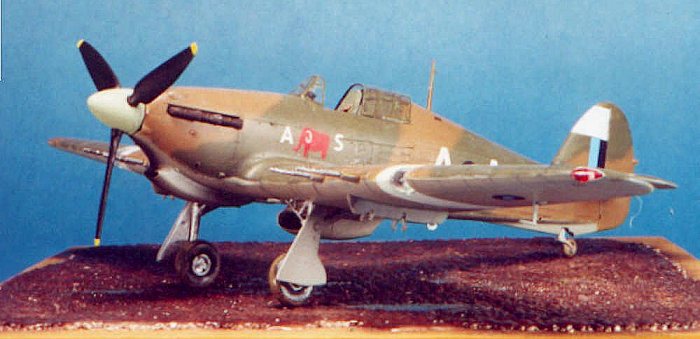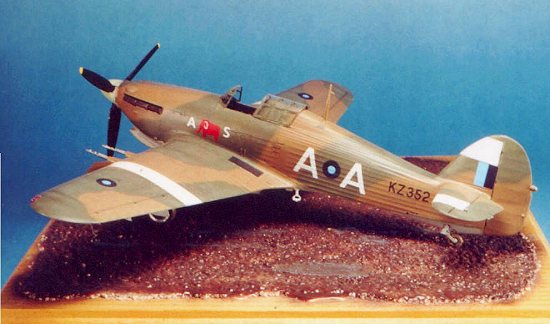
|
KIT: |
Hasegawa 1/48 Hurricane IIC |
|
KIT # |
9274 |
|
PRICE: |
$31.98 |
|
DECALS: |
See Review |
|
REVIEW & |
|
|
NOTES: |
|

|
HISTORY |
Eclipsed by publicity during the Battle of Britain by its more graceful-looking stablemate, the Spitfire, the Hawker Hurricane has always lived in the elliptical-winged shadow of Reginald Mitchell's revolutionary masterpiece. Rather than a stroke of genius, the Hurricane was evolutionary in its heritage, standing as it did atop the body of work of its designer, Sir Sidney Camm, who had and would design many of the most famous and successful aircraft used by the Royal Air Force for ten years previous and another thirty years after the Hurricane's appearance.
While the Hurricane was largely replaced in the front ranks of Fighter Command within a year of its victory - though it would serve another two years in the fighter-bomber role over Northwestern Europe - the airplane was in the thick of battles over Malta, the Western Desert, and Southeast Asia for the rest of the war; in service with the Fleet Air Arm, it would be involved in epic air battles defending Malta convoys in the Mediterranean, and flying off escort carriers to attack U-boats in the North Atlantic and on the Murmansk run. The Hurricane would remain in first-line service throughout the Second World War, one of only seven aircraft in service with any air force on September 3, 1939 about which that could be said.
Foreign Service:
During the War, the Hurricane served in more theatres of operation than any other aircraft, from England to the jungles of Malaya and Burma, from arctic Archangel in the U.S.S.R. to the Suez Canal and the Western Desert. In fact, the Hurricane is one of the very few aircraft of the Second World War to have flown in air forces on both sides, if one considers its service in the Finnish and Romanian Air Forces.
The "Flying Elephants":
 After the RAF and the Soviet Union, the largest user of Hurricanes was the
Royal Indian Air Force; following the dispatch of Hurricane Is from the Middle
East for training purposes in the Spring of 1942, enough Hurricane IIBs were
transferred to the RIAF in 1943 to equip No. 1 Squadron. In 1944, over 200
Hurricane IICs were transferred to equip seven RIAF squadrons in time for their
front line participation in the last Japanese offensive of the war, the fighting
on the Second Arakan and Imphal campaigns commencing in the summer of 1944; RIAF
squadrons, flying as both fighters and fighter-bombers aquitted themselves well
in direct air support of the Indian Army in numerous difficult situations, as
well as against what was left of the JAAF in the theatre. Many of these
Hurricanes were still in service with the RIAF at the time India gained
independence in 1947, and fought in the first India-Pakistan War, the last war
that would see the participation of Hurricanes.
After the RAF and the Soviet Union, the largest user of Hurricanes was the
Royal Indian Air Force; following the dispatch of Hurricane Is from the Middle
East for training purposes in the Spring of 1942, enough Hurricane IIBs were
transferred to the RIAF in 1943 to equip No. 1 Squadron. In 1944, over 200
Hurricane IICs were transferred to equip seven RIAF squadrons in time for their
front line participation in the last Japanese offensive of the war, the fighting
on the Second Arakan and Imphal campaigns commencing in the summer of 1944; RIAF
squadrons, flying as both fighters and fighter-bombers aquitted themselves well
in direct air support of the Indian Army in numerous difficult situations, as
well as against what was left of the JAAF in the theatre. Many of these
Hurricanes were still in service with the RIAF at the time India gained
independence in 1947, and fought in the first India-Pakistan War, the last war
that would see the participation of Hurricanes.
|
THE KIT |
The Hasegawa Hurricane IIc was first released in 1995; the SEAC kit - which includes the Vokes tropical filter - was released in early 1997. The SEAC kit includes kit decals for an RIAF Hurricane IIc, but I elected to use the better decals of the Aeromaster "Foreign Hurricanes" sheet which is now out of production. If you can find this sheet, get it. It includes a Finnish Hurricane Mk.I in Continuation War markings, a Romanian Mk.I, a Royal Yugoslav Hurricane I and a late war Yugoslav Hurricane IV flying with the Desert Air Force, and a Hurricane Mk. I of the Irish Free State Air Corps as well as this Indian Air Force Mk.IIc. Designed by the well-renowned Jennings Heilig, it is one of the sheets that made the Aeromaster reputation before such jokes as "Error-master" began to make the rounds.
|
CONSTRUCTION |
I refer you to my other articles here at Modeling Madness on building the Hasegawa Hurricane. This is a kit that can be built out of the box, needing only a set of seat belts and a vacuformed canopy - I used the old True Details seatbelt set, and a Squadron vacuformed canopy with this kit. The only difficulty is that Hasegawa engineered the kit so that the join of the lower wing and the rear fuselage cuts through a fabric area of the rear fuselage; the only thing one can do is fill the gap, and re-sand the fabric effect with a rat-tail file. It's a pain in the neck, but there you are.
|
PAINT & DECALS |
 RAF aircraft in the South East Asia Command were repainted from the standard
RAF camouflage of Ocean Grey and Dark Green upper surfaces with Sea Grey Medium
lower surfaces to a more theatre-appropriate camouflage of Dark Earth over the
Ocean Grey, with the Dark Green and the Sea Grey Medium colors. As such, this
means one does not have to mask off the color demarcations and can freehand the
camouflage. That's good news for those of us with a steady hand and bad news for
the others; for the "Shaky Jakes" among us - and those whose airbrush
won't tighten down to a pencil-width paint stream - I recommend you mask off the
camouflage with drafting tape, and run thread about 1/16" in from the edge,
to lift the tape. Aim in a bit instead of away from the demarcation, and you'll
get an accurate and in-scale "overspray." I used Gunze-Sanyo Dark
Earth and Dark Green, and Tamiya "Medium Grey" (which is Sea Grey
Medium), after "pre-shading the model, then airbrushing and masking off the
white SEAC theatre markings.
RAF aircraft in the South East Asia Command were repainted from the standard
RAF camouflage of Ocean Grey and Dark Green upper surfaces with Sea Grey Medium
lower surfaces to a more theatre-appropriate camouflage of Dark Earth over the
Ocean Grey, with the Dark Green and the Sea Grey Medium colors. As such, this
means one does not have to mask off the color demarcations and can freehand the
camouflage. That's good news for those of us with a steady hand and bad news for
the others; for the "Shaky Jakes" among us - and those whose airbrush
won't tighten down to a pencil-width paint stream - I recommend you mask off the
camouflage with drafting tape, and run thread about 1/16" in from the edge,
to lift the tape. Aim in a bit instead of away from the demarcation, and you'll
get an accurate and in-scale "overspray." I used Gunze-Sanyo Dark
Earth and Dark Green, and Tamiya "Medium Grey" (which is Sea Grey
Medium), after "pre-shading the model, then airbrushing and masking off the
white SEAC theatre markings.
The decals went down with no problem under a coat of Micro-Sol.
Final Finish:
From what I have read, the RIAF went out of the way to keep their airplanes looking good even in the field, since they had fought so hard to become a serious combat force. Therefore, I only "dinged" the airplane around the cowling release and the gun bay covers, and the area of the wing where the pilot and crew chief would have stood during boarding. I also gave some exhaust stains with highly-thinned light grey, oversprayed with Tamiya "Smoke."
|
CONCLUSIONS |
I now have a complete collection of Hurricanes and Sea Hurricanes of all operational marks, and a representation of the different air forces and theatres in which the airplane served; it's a nice collection that's almost as colorful and varied as my Spitfires.

If you would like your product reviewed fairly and quickly by a site that averages over 2,000 visits a day, please contact me or see other details in the Note to Contributors.